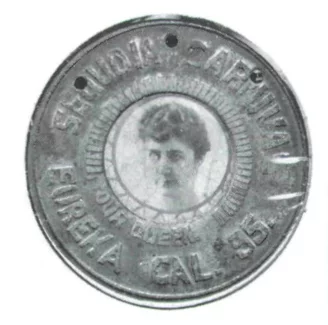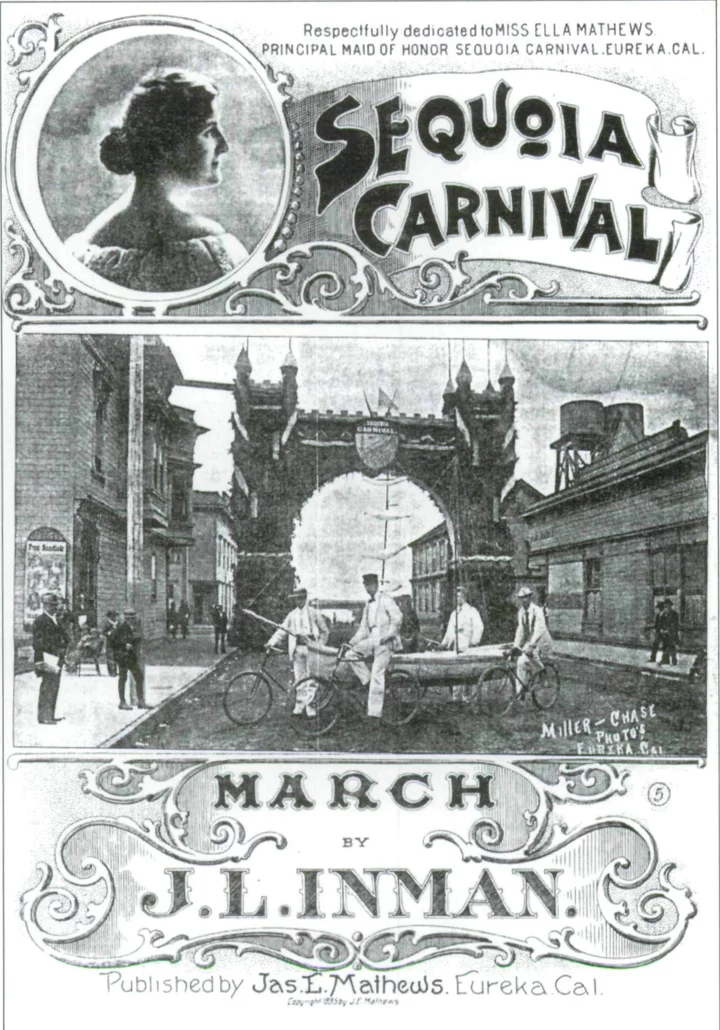The spring of 1895 brought a trio of festivals to Northern California. These celebrations were dubbed “Floral Fiestas” in newspaper accounts of the day.
Santa Rosa played host to the first Floral Fiesta, followed by Healdsburg in mid-May 1895. Apparently Eurekans were also caught up in the spirit of the festivities and organized their own “Sequoia Carnival” for July 18, 19 and 20. This festival ultimately outshone its counterparts to the south.
In mid-June, the town started gearing up for the festival with the announcement of the contest for Queen Sequoia. Ballots appeared daily in the Humboldt Times, eight per issue, and everyone was urged to write in a candidate for Queen as many times as they pleased. The final tally of votes confirms that the citizenry did indeed have their favorites and exercised their right to vote often and aggressively, many with gold coin and check book.

This small metal badge, approximately 1.5 inches in diameter, featured a photo of Queen Sequoia. Photos via the Humboldt Historian.
Saturday, July 14, at 8 p.m. saw the closing time for voting. The astounding number of 146,210 votes had been cast for the top three contenders for Queen Sequoia. It took some time to count the votes and when the results were exhibited to the crowd of over 2,000 assembled, the prolonged cheering could be heard for blocks. The final tally: Elma Haight 68,655; Ella Mathews 67,860; Annie Evans 9,695.
Elma Haight of Rohnerville was crowned Queen Sequoia and reigned over the festivities; and what festivities they were: parades, bicycle races, a firemen’s tournament, visiting dignitaries and more. Contestants for the various games arrived all week long. Bicycle racers came from San Francisco, San Jose, and the interior. The Humboldt Times reported this: “the grandest aggregation of crack wheelmen ever gathered in Northern California.” Fire apparatus was arriving on steamers, including the famous Pilot Hose Cart No. 3 from Santa Cruz, for the Hose Cart Races. Merchants were decking out their buildings and streets with redwood boughs, and taxidermist Charles Fiebig arranged his display of over 200 native Humboldt birds at Second and E Streets. This collection was reputed to be the finest in the state.
The booming of a cannon ushered in the first day of the Sequoia Carnival. Trainloads of people traveled in from the north, south, and inland towns. At noon the coronation of Queen Sequoia commenced at the plaza comer of Sixth & F Streets, then on to the parade under military escort. Participants included the militia and the city’s entire fire department of six companies, with flower- covered steamers, trucks and carts. Nearly all fraternal and social organizations from Eureka and surrounding towns participated, and 61 floats representing all the leading businesses and industries of the city were on hand. The parade was the largest ever witnessed in Northern California and took three hours to wind its way through the business district. The evening of the first day of the Sequoia Carnival featured a “grand water fete” on the bay, with the water covered with steamers, barges, launches, and row and sail boats illuminated with lanterns, exploding rockets and Roman candles.
This was the cover page to the Sequoia Carnival March, a piece of music written in honor of Ella Mathews. The sheet music was published by James E. Mathews, Ella’s father, who owned a music store.
The second day of the festivities again began with trainloads of visitors arriving and by 10 a.m. the streets were thickly crowded. The highlight of the morning was the firemen’s tournament. Besides the Santa Cruz racing cart entry, Eureka Engine Companies No. 1, 2, and 3 and Hook and Ladder Co. No. 1 participated. The course was F Street between Second and Fourth. The teams started at Fourth Street, taking the hydrant at Third and breaking and putting on pipe at Second Street, equivalent to running 600 feet and laying 300 feet of hose. Engine Co. No. 3 made the first run and had a stream in the air in 40.5 seconds. Hook and father, who owned a music store. Ladder Co. No. 1 had trouble connecting the pipe and took 71 seconds to complete the task. Engine Co. No. 1 took the cart and made the run and had water in 40 seconds. Last came Engine Co. No.2, holders of the Eureka Fire Department’s gold medal. Their appearance brought a burst of cheers from the large crowd, and they didn’t disappoint their admirers. They streaked down the course in 36.5 seconds, breaking all records.
The afternoon of day two included an open air concert, excursions to points of interest around the city and on the bay, and an exhibition by the U.S. Lifesaving Crew. The evening brought attention to Armory Hall, where Queen Sequoia and her attendants greeted a capacity crowd of over one thousand. First, the prize awards were given to the top parade entrants. The top prize of $15 was won by Arcata Sanitarium; other float winners included H.H. Buhne & Co., Z. Russ & Sons Meat Market, A. Rosaia, American Fish Market, Eureka Hardware Co., and The White House. After the prizes were distributed, the grand march commenced, accompanied by music from the 18-piece carnival orchestra. By 11 p.m. the grand ball was underway and lasted well into the morning hours.
The third and final day of the reign of Queen Sequoia was devoted to field sports and the cyclers. By previous arrangement all business houses closed at 1 p.m. and South Park race track became the center of attraction. The Humboldt Times reported that “people came on foot, on bicycles, on horse cars and in carriages, and it seemed as if every private and livery rig in the city was present. The three grandstands were filled to overflowing with ladies, while the men were packed in the enclosure below like sardines in a box.” Over four thousand spectators were estimated on the scene.
The cyclers were world class competitors and inspired spirited wagering among the crowd. Foot races were interspersed with the cycling events and purses for all races were generous, including fine silver watches, unset diamonds, bicycle suits, a diamond locket, a fine fishing rod and reel, a Marlin rifle, a pearl handled razor and suits of clothes. No records were set but there were some hot finishes. The evening brought a return of the crowd to Second and F Streets, where people gathered for the Illuminated Bicycle Parade, the closing feature of the carnival. Every bicycle was trimmed with ribbon and bunting, with some adding Japanese lanterns, red lights, and Roman candles. Of the 125 Bicycle Parade entrants, thirty were women who “were mostly dressed in white, and bloomers were the exception, the greater number of ladies wearing conventional short skirts.” Prizes were awarded to the best illuminated and best decorated bicycles.
When the wheelmen’s parade had passed, the immense crowd retreated once again to Armory Hall for the farewell reception. Surrounded by her faithful subjects. Queen Sequoia laid aside her crown and became once again Miss Elma Haight. With the abdication of Queen Sequoia, the Sequoia Carnival of 1895 came to a close. The city had never seen an event of such magnitude, and it is doubtful Eureka will ever again experience the all-out revelry of those three summer days 100 years ago.
###
The story above was originally printed in the Spring 1997 issue of the Humboldt Historian, a journal of the Humboldt County Historical Society. It is reprinted here with permission. The Humboldt County Historical Society is a nonprofit organization devoted to archiving, preserving and sharing Humboldt County’s rich history. You can become a member and receive a year’s worth of new issues of The Humboldt Historian at this link.

CLICK TO MANAGE